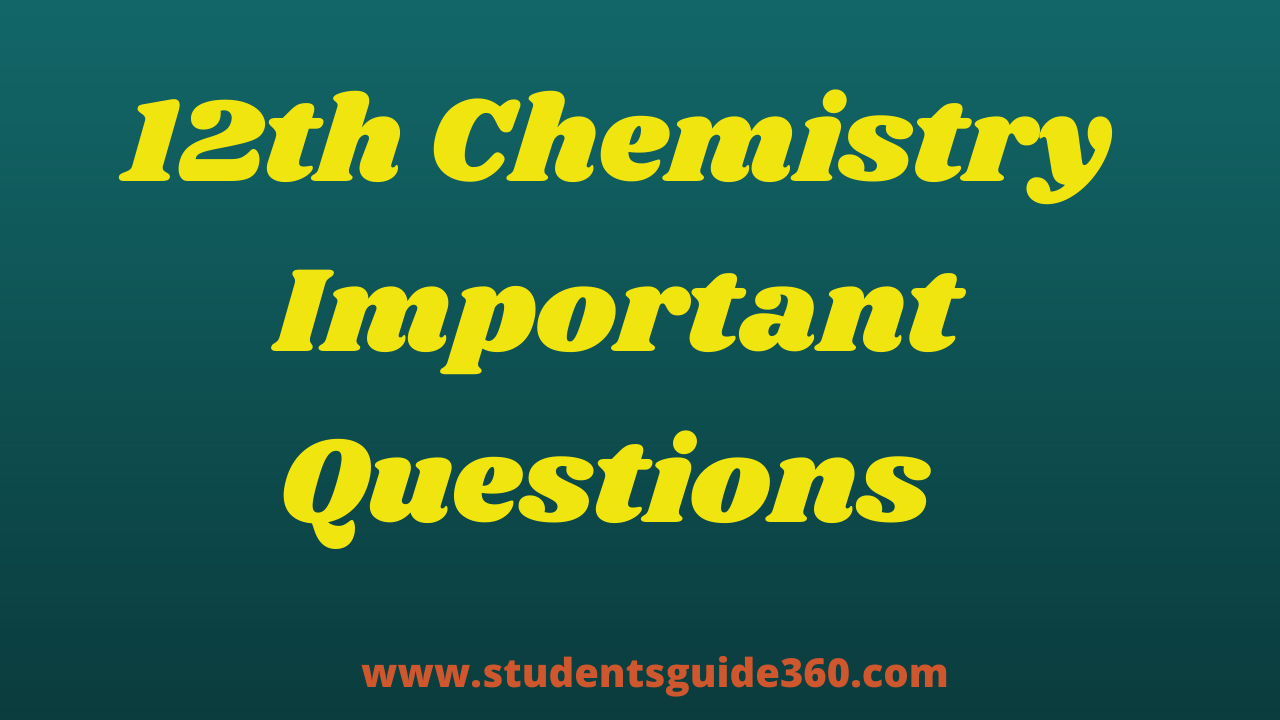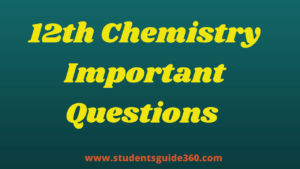12th Chemistry Important Questions Unit 12 Carbonyl Compounds and Carboxylic Acids
TN 12th Chemistry Important Questions Unit 12 Carbonyl Compounds and Carboxylic Acids. 12th Chemistry Important Questions Chapter 12. +2 Chemistry Important 2 Marks, 12th Chemistry Important 3 Marks, Chemistry Important 5 Marks Questions Based on reduced Syllabus 2021-2022. 12th Free Online Test (MCQs). HSC 12th Chemistry Revision Test Important Questions. 12th Tamil Full Guide.

12th Chemistry Important Questions Unit 12 Carbonyl Compounds and Carboxylic Acids
12th Chemistry All Units Important Questions
12. Carbonyl Compounds and Carboxylic Acids
- 1. How is propanoic acid is prepared to start from (a) alcohol (b) an alkylhalide (c) an alkene
- 2. A Compound (A) with molecular formula C2H3N on acid hydrolysis gives (B) which reacts with thionylchloride to give compound(C). Benzene reacts with compound (C) in presence of anhydrous AlCl3 to give compound(C). Compound (C) on reduction with gives (D). Identify (A), (B), (C), and D. Write the equations.
- 3. A hydrocarbon A(molecular formula C8H10 ) on ozonolysis gives B( C4H6O2 ) only. Compound C ( C3H5Br ) on treatment with magnesium in dry ether gives (D) which on treatment with CO2 followed by acidification gives(C). Identify A, B, and C.
- 4. An alkene (A) on ozonolysis gives propanone and aldehyde (B). When (B) is oxidised(C) is obtained. (C) is treated with Br2/P gives (D) which on hydrolysis gives (E). When propanone is treated with HCN followed by hydrolysis gives (E). Identify A, B, C, D, and E.
- 5. How will you convert benzaldehyde into the following compounds?
(i) benzophenone (ii)benzoicacid (iii)α-hydroxyphenylaceticacid. - 6. What is the action of HCNon?
(i) propanone (ii)2,4-dichlorobenzaldehyde. iii) ethanal - 7. A carbonyl compound A having molecular formula C5H10O forms a crystalline precipitate with sodium bisulphate and gives a positive iodoform test. A does not reduce Fehling solution. IdentifyA.
- 8. Write the structure of the major product of the aldol condensation of benzaldehyde with acetone.
- 9. How are the following conversions effected
(a) propanalinto butanone (b) Hex-3-yne intohexan-3-one.
(c) phenylmethanal intobenzoicacid (d) phenylmethanal intobenzoin - 10. Oxidation of ketones involves carbon–carbon bond cleavage. Name the product (s) is/are formed on oxidising 2,5 – dimethyhexan – 2- one using a strong oxidisingagent.
- 11. How will you prepare
i. Lactic acid from ethanal
ii. Acetophenone from acetylchloride
iii. Ethane from sodiumacetate
iv. Benzoic acid from toluene
v. Malachitegreen from benzaldehyde
vi. Cinnamic acid from benzaldehyde
vii. Acetaldehyde from ethyne - 12. Convert 2-Butene –> Ethanal
- 13. How will you prepare the following compounds from Ethanoic acid? a,Ethanal b, Propanone
- 14. Write a note on Rosenmund reduction. What is the purpose of adding BaSO4 in it?
- 15. Stephen’s reaction
- 16. Gattermann – Koch reaction
- 17. Clemmensen reduction
- 18. Wolf Kishner reduction
- 19. Claisen – Schmidt Condensation
- 20. Benzoin condensation
- 21. Perkins‟ reaction
- 22. Knoevenagal reaction
- 23. Etard reaction (or) Convert Toluene —> Benzaldehyde
- 24. Define Popoff ‟s rule.
- 25. Convert Acetone to Pinacols (or) Write a note on reduction to Pinacols
- 26. How will you prepare Urotropine? Write its structure and mention its uses
- 27. How does NH3 react with (i) Ethanal, (ii) Propanone, and (iii) Phenylmethanal.
- 28. Explain the mechanism of Aldol condensation?.
- 29. Write a note on Crossed Aldol condensation.
- 30. Explain the mechanism of the Cannizaro reaction?
- 31. Write a note on Crossed Cannizaro reaction
- 32. What happens when Benzaldehyde react with Chlorine for the following conditions
i) with catalyst ii) without catalyst - 33. Convert Benzaldehyde to Benzalanilide
- 34. Give two tests for aldehydes.?
- 35. How will you prepare Ethanoic acid from the following compounds a, Methylcyanide b, Grignard reagent c,Acetylchloride
- 36. How will you prepare the following compounds from Ethanoic acid a, Ethanol b, Ethane c, Methane
- 37. Convert Benzoic acid to m-sulphobenzoicacid
- 38. Explain the reducing property of Formicacid
- 39. Differenciate Ethanal – Phenylmethanal?
- 40. Differenciate Ethanal – Propanone?
- 41. DifferenciateMethanal – Ethanal?
- 42. Give two tests for Carboxylicacid
- 43. Differentiate Methanoic acid – Ethanoic acid
- 44. Differenctiate Ethanoic acid – Phenylmethanoicacid
- 45. Benzaldehyde and Formaldehyde give Cannizzaro reaction but Acetaldehyde give aldol condensation – give the reason?
- 46. How is Acetophenone prepared by the Friedel-Crafts method?
- 47. How is Benzophenone prepared by the Friedel-Crafts method?
- 48. Write a short note on i) Benedict‟s solution test ii) Etard Reaction.
- 49. Why Formic acid act as a strong reducing agent? Give one equation to show its reducing property.
- 50. Convert a) Benzene to Acetophenone
b) Benzaldehyde to Hydrobenzamide - 51. What will happen when 1-phenylethanol reacts with acid mixed KMnO4?
- 52. What is Formalin and write its uses.
- 53. An organic compound C3H4 (A) on hydration with Hg2+/H2SO4 gives compound (B) which gives a positive iodoform test. Compound „B‟ heated with NH2-NH2 / C2H5ONato gives hydrocarbon „C‟. „B‟ is also treated with HCHO in the presence of dilNaOH gives compound (D). Identify A, B, C& D. Write the chemical reactions involved.
- 54. An Organic Compound (A) – C2H4O reduces Tollen‟s and Fehling‟s solution. „A‟ react with methanol and HCl to give Compound (B) – C4H10O. „A‟ on reaction with Methanal in the presence of dilute NaOH to give Compound (C) – C3H6O2. Identify Compounds A, B, and C with necessary reactions
- 55. Compound „A‟ of molecular formula C7H6O reduces Tollen‟s reagent. When „A‟ reacts with 50% NaOH gives Compound „B‟ of molecular formula C7H8O and „C‟ of molecular formula C7H5O2Na. Compound „C‟ on treatment with dil HCl gives compound „D‟ of molecular formula C7H6O2. When „D‟ is heated with Soda lime give compound „E‟. Identify „A‟ to „E‟. write the corresponding equations.


